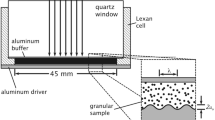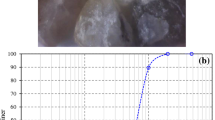Abstract
By the discrete element method (DEM), we perform numerical simulations of shock-induced load transfer processes in granular layers composed of spherical particles packed in vertical channels. In order to isolate the load transfer through the grains’ contact points from the complicated load transfer processes, we simulate the shock wave interactions with granular layers having no permeability for gas. The shock loading is achieved by applying a downward step force on the top of the granular layers. Complex, three-dimensional load transfer processes in the granular media, which are extremely difficult to understand from experiments, are visualized based on the results from the present DEM simulation. The numerical results show that highly concentrated load transfer paths, through which shock loads are transferred mainly, exist in the granular media, and that the dimensions of the container of the granular media considerably affect the shock-induced load transfer processes. From a coarse-grained representation of intergranular stress, wave-like load transfer processes are clearly observed. For relatively deep granular layers, however, the wave fronts became unclear as they propagated.
Similar content being viewed by others
References
Jaeger H.M., Nagel S.R., Behringer R.P.: Granular solids, liquids, and gases. Rev. Mod. Phys. 68, 1259–1273 (1996)
Britan A., Levy A.: Weak shock wave interaction with inert granular media. In: Ben-Dor, G., Igra, O., Elperin, T. (eds) Handbook of Shock Waves, vol. 2., pp. 597–666. Academic Press, San Diego (2001)
Suzuki, T., Adachi, T.: A basic study of the blast waves over a dust deposit. In: The Japan National Committee for Theoretical and Applied Mechanics (ed.) Theoretical and Applied Mechanics, vol. 31, pp. 439–446. University of Tokyo Press, Tokyo (1982)
Adachi, T., Suzuki, T.: The singular pressure wave in a dust layer over which a shock wave is propagating. In: Archer, R.D., Milton, B.E. (eds.) Proceedings of the 14th International Symposium on Shock Tubes and Waves, pp. 497–504 (1983)
Gelfand B.E., Medvedev S.P., Borisov A.A., Polenov A.N., Frolov S.M., Tsyganov S.A.: Shock loading of stratified dusty systems. Arch. Combust. 9, 153–165 (1989)
Sakakita, H., Hayashi, A.K.: Study on pressure profiles in a powder layer using a vertical shock tube. In: Proceedings of the Symposium on Shock Waves, Japan ’92, pp. 655–660 (1992)
Ben-Dor G., Britan A., Elperin T., Igra O., Jiang J.P.: Experimental investigation of the interaction between weak shock waves and granular layers. Exp. Fluid 22, 432–443 (1997)
Britan A., Ben-Dor G., Elperin T., Igra O., Jiang J.P.: Mechanism of compressive stress formation during weak shock wave impact with granular materials. Exp. Fluid 22, 507–518 (1997)
Britan A., Ben-Dor G., Elperin T., Igra O., Jiang J.P.: Gas filtration during the impact of weak shock waves on granular layers. Int. J. Multiph. Flow 24, 473–491 (1997)
Britan, A., Ben-Dor, G., Levy, A., Igra, O.: Shock wave interaction with granular materials. In: Ball, G.J. et al. (eds.) Proceedings of the 22nd International Symposium on Shock Waves, pp. 1375–1380 (2000)
Mikami, H., Kaneda, T., Sakamura, Y., Suzuki, T.: Head-on collisions of a planar shock wave with a dust layer, In: Kimura, T. (ed.) Theoretical and Applied Mechanics, vol. 49, pp. 263–270 (2000)
Britan A., Ben-Dor G., Igra O., Shapiro H.: Shock wave attenuation by granular filters. Int. J. Multiph. Flow 27, 634–671 (2001)
Glam B., Igra O., Britan A., Ben-Dor G.: Dynamics of stress wave propagation in a chain of photoelastic discs impacted by a planar shock wave; Part I, experimental investigation. Shock Waves 17, 1–14 (2007)
Goldenberg A., Igra O., Britan A., Ben-Dor G.: Dynamics of stress wave propagation in a chain of photoelastic discs impacted by a planar shock wave; Part II, numerical investigation. Shock Waves 17, 15–27 (2007)
Cundall P.A., Strack O.D.L.: A discrete numerical model for granular assemblies. Géotechnique 29, 47–65 (1979)
The Society of Powder Technology, Japan: Introduction to Powder Simulation (in Japanese). Sangyo-Tosho, Tokyo (1998)
Duran J.: Sands, Powders, and Grains: An Introduction to the Physics of Granular Materials. Springer, New York (1999)
Pöschel T., Schwager T.: Computational Granular Dynamics: Models and Algorithms. Springer, Berlin (2005)
Tanaka K., Nishida M., Kunimochi T., Takagi T.: Discrete element simulation and experiment for dynamic response of two-dimensional granular matter to the impact of a spherical projectile. Powder Technol. 124, 160–173 (2002)
Nishida M., Tanaka K., Matsumoto Y.: Discrete element method simulation of the restitutive characteristics of a steel spherical projectile from a particulate aggregation. JSME Int. J. Ser. A 47, 438–447 (2004)
Nishida, M., Tanaka, K., Ishida, T.: DEM simulation of wave propagation in two-dimensional ordered array of particles. In: Hannemann, K., Seiler, F. (eds.) Proceedings of the 26th International Symposium on Shock Waves, pp. 815–820 (2009)
Nishida M., Tanaka Y.: DEM simulations and experiments for projectile impacting two-dimensional particle packings including dissimilar material layers. Granul. Matter 12, 357–368 (2010)
Nishida M., Nagamatsu J., Tanaka T.: Discrete element method analysis of ejection and penetration of projectile impacting granular media. J. Solid Mech. Mater. Eng. 5(4), 164–178 (2011)
Kano, J.: Study on powder simulation by particle methods (in Japanese). Doctor Thesis, Graduate School of Engineering, Doshisha University (1996)
Timoshenko S.P., Goodier J.N.: Theory of Elasticity, 3rd edn, pp. 409–414. McGraw-Hill, Auckland (1970)
Sakakibara, Y.: Two-dimensional discrete element method analysis of a shock-loaded granular layer (in Japanese). Master Thesis, Graduate School of Mechanical Systems Engineering, Toyama Prefectural University (2006)
Mindlin R.D.: Compliance of elastic bodies in contact. J. Appl. Mech. 16, 259–268 (1949)
Mindlin R.D., Deresiewicz H.: Elastic spheres in contact under varying oblique forces. J. Appl. Mech. 20, 327–344 (1953)
The POV-Team: POV-Ray Reference for POV-Ray Ver. 3.6.1. POV-Ray official site. http://www.povray.org. Accessed 25 Feb. 2011
Roessig K.M., Foster J.C. Jr, Bardenhagen S.G.: Dynamic stress chain formation in a two-dimensional particle bed. Exp. Mech. 42, 329–337 (2002)
Author information
Authors and Affiliations
Corresponding author
Additional information
Communicated by O. Igra.
Rights and permissions
About this article
Cite this article
Sakamura, Y., Komaki, H. Numerical simulations of shock-induced load transfer processes in granular media using the discrete element method. Shock Waves 22, 57–68 (2012). https://doi.org/10.1007/s00193-011-0347-6
Received:
Revised:
Accepted:
Published:
Issue Date:
DOI: https://doi.org/10.1007/s00193-011-0347-6




